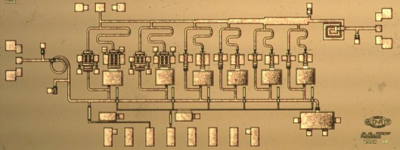
HRL Amplifier Circuit Keeps Communications Clear Under Electronic Warfare

Circuit diagram of novel GaN power amplifier that demonstrated linear amplification over 100 MHz to 6 GHz for agile spectrum access. © 2017 HRL Laboratories.
A team from HRL’s Microelectronics Laboratory led by Jeong-Sun Moon has developed a linear wideband distributed amplifier circuit to enable clear, consistent communication between systems operating in some of the world’s most difficult situations. Measuring 2mm x 3mm, this tiny but powerful circuit can amplify a communications signal with very high spectral purity and ~10x improved dynamic range over state-of-the-art amplifiers at the same DC power consumption for transmission or reception with greatly reduced harmonic distortion. Funded by the US Office of Naval Research (ONR), this work was presented in 2017 at the annual IEEE Radio & Wireless Week Conference.
“What makes the circuit special is that it operates on a wide band of frequencies with spectral purity,” Moon said. “In electronic warfare, with cluttered electromagnetic environments, dynamic spectrum access is very important. If your adversary is trying to jam you in an attack situation, this extremely wideband linear amplifier can be utilized in agile communication systems to move its communication signal around the spectrum instantly to find an available clear frequency. Such an agile communication systems would help prevent signal dropping at important moments and would help keep communication lines open. Also, in complex situations when many people may be communicating simultaneously, radio frequency signals mix. This causes distortion to all signals and the overall communication quality drops. The signal purity of this linear wideband amplifier helps keep communication clean and clear at all times.”
Moon and his colleagues used high electron mobility transistors made from gallium nitride (GaN) because they enable transmissions with ~6-7 times more power than other commonly used radio frequency transistors such as gallium arsenide (GaAs) devices. Because of the extreme linearity requirement over wideband operation, the HRL team had to develop a new approach to making the amplifier chain more linear, the key to achieving the desired purity of its amplified radio signal.
“Our amplifier’s architecture has the wide-band distortion cancellation scheme built into it,” Moon said. “This means that our patented circuit reduces harmonic distortion. We tested the clarity of the amplifier on 4G cellular systems and they came out very clean.”
The applications of the amplifier are wide ranging as well. Besides cellular phones, the amplifier could improve communication between ships, aircraft, and even unmanned aerial vehicles (UAVs). As autonomous UAVs become more pervasive in combat scenarios, often in large swarms, the need for communication between them to coordinate missions grows exponentially. Because such drones can attain proximity to an enemy that would be extremely hazardous for human soldiers, the need for clear radio signals is paramount. Maintaining a clean radio frequency despite jamming attempts has a clear advantage under combat conditions.
For civilian use, this technology is relevant to base stations that want to cover as many cellular bands from as many carriers as possible. The electronic warfare radio frequency spectrum is wider than the cellular phone spectrum, thus the amplifier could easily be suited for cellular use.
“It’s possible that in cell phones, because the spectrum would be narrower, we could make the amplifier more efficient, less expensive, and an easy fit into current power usage requirements,” Moon said.
Other researchers on the linear wideband amplifier team were Jongchan Kang, Robert Grabar, Helen Fung, Peter Chan, Haw Tai, and Dave Brown.
This material is based upon work supported by the Office of Naval Research (ONR) under Contract No. N00014-14-C-0140. The views expressed are those of the author and do not reflect the official policy or position of the Office of Naval Research (ONR) or the U.S. Government.
HRL Laboratories, LLC, California (hrl.com) pioneers the next frontiers of physical and information science. Delivering transformative technologies in automotive,aerospace and defense, HRL advances the critical missions of its customers. As a private company owned jointly by Boeing and GM, HRL is a source of innovations that advance the state of the art in profound and far-reaching ways.
Media Inquiries: media[at]hrl.com, (310) 317-5000